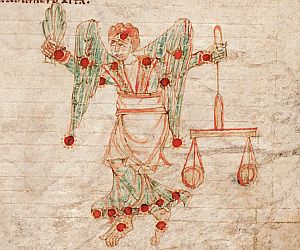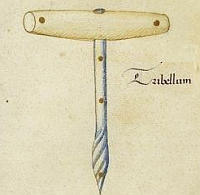Wikipedia
R.H. Allen:
Star Names
Ian Ridpath:
Star Tales
Universe Guide
Sea and Sky:
Constellations
IAU
Map
NASA:
Constellations
|
Wikipedia |
R.H. Allen: Star Names |
Ian Ridpath: Star Tales |
Universe Guide |
Sea and Sky: Constellations |
IAU Map |
NASA: Constellations |


|
|
VirgoStar Lore |
|


|
Virgo is the largest constellation of the
Zodiac and the second largest constellation in the sky.
In many ancient cultures, the constellation represents maidens, fertility, and purity.
|


|
|
Ancient Mesopotamia
While almost all of the (Greek) Ptolemaic Constellations
have their roots in ancient Mesopotamia, there was no virgin in Mesopotamian star charts.
|

|


|
|
Greek Mythology
Early in Greek mythology, the constellation was associated with Demeter, the Greek goddess
of harvest and agriculture, similar to the Babylonian interpretation.
|
 Virgo with palm frond and scales
Virgo with palm frond and scalesAberystwyth Folios; Souce: Wikipedia
|
In this tale,
Dionysus had taught Icarius how to make wine. Icarius gave his wine to some shepherds, who
rapidly became drunk. Not knowing what had happened to them, the suspected Icarius of poisoning them and killed Icarius.
 When Erigone and Icarius' dog Maera (see Canis Minor) discovered the slain Icarius, they both took their own lives where Icarius lay. Zeus places Icarius, Maera and Erigone in the stars as the constellations Boötes, Canis Minor and Virgo.  Perhaps the most common depiction of this constellation was that of Dike, goddess of justice and the spirit of moral order, often referred to as Dike Astraea.  In Greek mythology, Astraea, the "Star-Maiden" was the last of the immortals to live with humans during the first two Ages of Man. Greek poet Ovid divided history into four Ages and Dike Astraea's story is directly related to these ages.  Ian Ridpath tells the story, using the name Dike:  |
 Erigone by Charles André van Loo
Erigone by Charles André van Loo(1747); Source: Wikipedia |
"Dike was supposed to have lived on Earth in the Golden Age of mankind, when Cronus ruled Olympus.
It was a time of peace and happiness, a season of perennial spring when food grew without cultivation and humans never grew old. Men lived like
the gods, not knowing work, sorrow, crime, or war. Dike moved among them, dispensing wisdom and justice.
 Then, when Zeus overthrew his father Cronus on Olympus, the Silver Age began, inferior to the age that had just passed. In the Silver Age, Zeus shortened springtime and introduced the yearly cycle of seasons. Humans in this age became quarrelsome and ceased to honor the gods.  Dike longed for the idyllic days gone by. She assembled the human race and spoke sternly to them for forsaking the ideals of their ancestors. ‘Worse is to come’, she warned them. Then she spread her wings and took refuge in the mountains, turning her back on mankind. |
 Virgo in Sky of Salamanca
Virgo in Sky of Salamanca15th century Fresco by Fernando Gallego Souce: Wikipedia |
 Finally came the Ages of Bronze and Iron, when humans descended into violence, theft, and war. Unable to endure the sins of humanity any longer, Dike abandoned the Earth and flew up to heaven, where she sits to this day next to the constellation of Libra, which some see as the scales of justice." [End of quote].  Sources: Ian Ridpath, Wikipedia |

|
|
Greek Star Names
The name Syrma (Σύρμα) was given to
ι Virginis by
Ptolemy, describing
the Train of the Virgin's robe.
|


|
|
Roman Mythology
The transition from Dike Astraea to Virgo happened relatively late in Greek history. Both Ptolemy, in the
Almagest, and
Hyginus in the
Poeticon Astronomicon called the constellation Παρθένος -
Parthenos, which is Greek for virgin.
|
 Parthenos in Poeticon Astronomicon
Parthenos in Poeticon AstronomiconSource: fineartamerica.com |

|
|
Latin Star Names
Spica the name of α Virginis goes back to the Mesopotamian interpretation of parts of the
constellation Virgo being seen as an ear of grain.
Going along with the theme of fertility, Porrima (γ Virginis) is named after one
of the Roman goddesses of childbirth. According to Wikipedia, Antevorta, also known as
Porimma, and her sister Postvorta "... were invoked by pregnant women as protectors against the dangers of childbirth."
Vindemiatrix, the name of ε Virginis is Latin for the grape-harvestress. It
is a Latin translation of the Greek Protrygetor (Προτρυγετής), used by Ptolemy.
|


|
|
Germanic Mythology
In his interpretation of the Völundarkviða, a mythological poems of the
Poetic Edda,
Peter Krüger identifies the constellation Virgo as
Böðvildr (or Bodhild), daughter of king
Niðhad (who, in Krüger's theory is represented by
Boötes).
|
 Böðvildr, handing the broken ring to Weyland
Böðvildr, handing the broken ring to Weyland1901 illustration by Johannes Gehrts Source: religion.wikia.org |
| Source: Germanic Astronomy: The Kneeling man and the Virgin with the Golden Ring |



|
|
Medieval Europe - Vexillum and Tarabellum
Roughly one half of today's constellation was defined by Ptolemy in the first century. The other half was the
result of the Age of Discovery in the 15th and 16th century.
In the 1,400 years between these two eras, only two new constellations creations were added to the European sky.
|
 
  Il Dittamondo, 1355
Souce: atlascoelestis.com
Il Dittamondo, 1355
Souce: atlascoelestis.com |



|
|
Arabian Peninsula: as-simakan - The Sky Raisers
as-simakan (السماكان), The Sky Raisers is one of eleven
Folkloric Celestial Complexes identified in the Arabic Star Catalog, developed by
Danielle Adams at the University of Arizona in Tucson.
|

|
The Two Sky-Raisers, the brightest and tenth brightes stars
visible in the night sky of the northern hemisphere were "... the pillars that held up the canopy of the heavens."
 The complex was divided into two parts. The Spear-Bearing Sky-Raiser and the Unarmed Sky-Raiser.  as-simak al-a’zal (السماك الأعزل), The Unarmed Sky-Raiser, the lower one of the Two Sky-Raisers, was represented by Spica, the brightest star in the constellation Virgo. It resides on a Throne, made up of stars from today's constellations Corvus. |

|
Source: Arab Star Calendars For the Spear-Bearing Sky-Raiser, see the detailed description of the constellation Boötes For more information on this ancient Sky Raiser complex, see Danielle Adams' essay The Setting of the Arabian Sky-Raisers: Widespread rains of summer. |

|


|
|
Islamic Astronomy
Today, α Virginis goes by the Latin name Spica (see above). In the Arab world, the star
was known as as-simak al-a’zal, the Unarmed Sky-Raiser (see above). Other Arabic names were Alarph, the grape-gatherer and
Sumbalet, derived from sunbulah (سنبلة), Ear of Grain - both Arabic translations of traditional Greek and Latin names.
The Arabic name for ε Vir was Mukdim al Kitāf - a
translation of its Latin name Vindemiatrix, the grape-harvestress.
R.H. Allen puts
ι Virginis, together with
κ and φ Virginis in a Lunar
Mansion called al-ghafr (الغفر) the Covering.
R.H. Allen calls al-ghafr the
13th Lunar Mansion. Ihsan Hafez, on the other hand,
numbers it as the 15th Lunar Mansion and names the stars belonging to it as
ι,
λ and
χ Virginis.
|


|
|
Coptic Star Names
Walter Ewing Crum, a Scottish scholar in Coptic language identified the source of
Khambalia, the name of |


|
|
al ʽawwāʼ - the Barker
In a star catalogue published by Egyptian astronomer
Muḥammad al-Akhṣāṣī al-Muwaqqit, a V-shaped asterism
(now called the Bowl of Virgo) was called al ʽawwāʼ, the Barker.
|
 Al ʽAwwāʼ - the Barker
Al ʽAwwāʼ - the BarkerMap based on a map provided by seasky.org |
 In the "Barker" constellation, the name of β Vir, zāwiyat al-awwa’, corner of the barker was the origin of the star's modern name Zavijava.  al-Muwaqqit's name for γ Vir was Laouiyet al Aoua, the angle of the barker.'  δ Vir was called Min al-ʽawwāʼ, meaning "in the lunar mansion of ʽawwāʼ." It is the root of its modern name Minelauva.  The traditional (and official) name for η Vir is Zaniah (from zāwiyah, meaning corner). However, in al-Muwaqqit's catalogue, it was called Thanih al Aoua, the second barker.  In addition to the five stars of the "Bowl", μ Virginis bore the name Rijl al-‘awwā’, foot of the barker.  Sources: R.H. Allen, Wikipedia, Ihsan Hafez |


|
|
Ancient India
In Hindu astronomy, Spica (α Vir) forms the 14th Lunar Mansion or
Nakshatra, called Chitra, the Bright One.
|
 Vishvakarma
VishvakarmaSource: Wikipedia |


|
|
Ancient China In Chinese, Virgo is written 室女座
The northern part of Virgo is located in Tài Wēi Yuán, the
Supreme Palace Enclosure.
|
 Chinese asterisms in Virgo
Chinese asterisms in VirgoMap based on seasky.org
|

The Left and Right Wall enclose a total of seventeen asterisms, most of them representing various groups of dignitaries, military and court officials. They
belong to six different western constellations. Three of the asterisms are located within Virgo:
 Sāngōng, Three Excellencies are formed by 31 and 35 Virginis, Jiǔqīng, Nine Ministers or Nine Senior Officers is formed by faint stars around ρ Virginis and Yèzhě, the Usher to the Court are centered at 16 Virginis.  Sources: Wikipedia, Ian Ridpath
In China, the southern part of the constellation Virgo is located in the direction of the Azure Dragon of the East occupying two of the seven Lunar Mansions in this quadrant. |
 Three Excellencies; Wikiversity
Three Excellencies; Wikiversity
|

Jiǎo, the Horn (of the Azure Dragon) is the name of the
First Lunar Mansion in Chinese Astronomy.
 The name Jiǎo is also given to an asterism consisting of α and ζ Virginis  The two stars also form one of many so-called gateways for the Sun, Moon, and planets, formed by stars located on opposite sides of the ecliptic.  Another one of these gateways, consisting of θ and 82 Virginis is called Píngdào, the Flat Road. It is seen as a straight road for the Sun, Moon, and the planets.  Yet another gate, called Tiānmén, the Celestial Gate is formed by the faint stars 53 and 69 Virginis.  Also part of the First Lunar Mansion is a heavenly field, called Tiāntián, the Celestial Farmland, consisting of τ and σ Virginis (or possibly 78 Virginis. According to Ian Ridpath, the Emperor ordered the heavenly fields to be plowed "...every spring before the year’s crops were sown."  Finally, there was a single star called Jìnxián, literally "Recommending Virtuous Men." Ian Ridpath describes the star as "...representing people of outstanding achievement being recommended for honors or awards." and identifies it as possibly θ Virginis, while Wikipedia assigns the asterism to 44 Virginis.
Kàng, the Neck (of the Azure Dragon) is the name of
Second Lunar Mansion in Chinese Astronomy.
Ian Ridpath adds two more interesting facets to the picture of Kàng.
|
 Dragon Horns; © missmonster
Dragon Horns; © missmonster
|

Ian Ridpath continues: "Near Kang was the similarly named Kàngchí, representing a lake with sailing boats. According to Sun and Kistemaker, Kàngchí originally
consisted of 110, 109,
and  Sources: Wikipedia and Ian Ridpath |


|
Back to Star Lore |
Back to Mythology |
Back to Space Page |
Back to English |
 Back to Start Page |